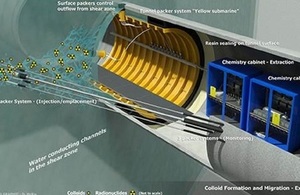International study of underground radionuclide migration
Experiments are under way in Switzerland to investigate how radionuclides could migrate, via groundwater, through buffer material in a geological disposal facility (GDF).

Schematic of the experimental layout for the colloid formation and migration studies
Challenge
Understand long-term processes that may impact on the performance of buffer materials in a potential GDF.
Solution
Collaborate on international experiments to measure possible migration route of radionuclide-carrying colloids in groundwater using existing international facilities.
Technology
Underground research laboratory, radionuclide tracer sampling.
Benefits
Knowledge will enable development and refinement of future barrier systems.
Status
Further comparison of data from sampling points with modelling predictions to determine next steps.
Research partners
For the current phase:
- BMWI / KIT (Germany)
- JAEA (Japan)
- SKB (Sweden)
- CRIEPI (Japan)
- KAERI (Korea)
- POSIVA (Finland)
- DOE (USA)
- RWM (UK)
- NUMO (Japan)
- NAGRA (Switzerland)
Website
Grimsel test site: Colloid Formation and Migration Introduction
Innovation route
Collaboration with overseas partners to ensure benefit from existing international facilities and programmes
Details
Natural rock formations and multiple engineered barriers will protect containers of high-level radioactive waste in underground repositories for many thousands of years.
As part of a collaboration with seven international partners, Radioactive Waste Management (RWM) is carrying out work to understand how the packaged waste will react with the surrounding geology and groundwater over the long-term.
Experiments are being carried out over a number of years at Switzerland’s underground laboratory in Grimsel to investigate the ways in which radionuclides could migrate via groundwater through the thick layers of bentonite clay that will be used as a buffer around the containers.
In addition to the underground work, a complementary computational modelling programme is looking at how radionuclide particles could attach to bentonite dissolution products to form colloids and be mobilized by groundwater flow. This will help predict the long-term behaviour and movement of the radionuclides beyond an engineered barrier system.
The underground and computational modeling programmes are combined with lab studies using different materials that will typically be present around a GDF, such as granite. This enables comparisons with controlled underground experiments based on existing boreholes and injected radioisotopes in a wide range of conditions. International collaboration is an effective way to ensure a comprehensive programme is addressing all potential areas of theoretical and experimental work.